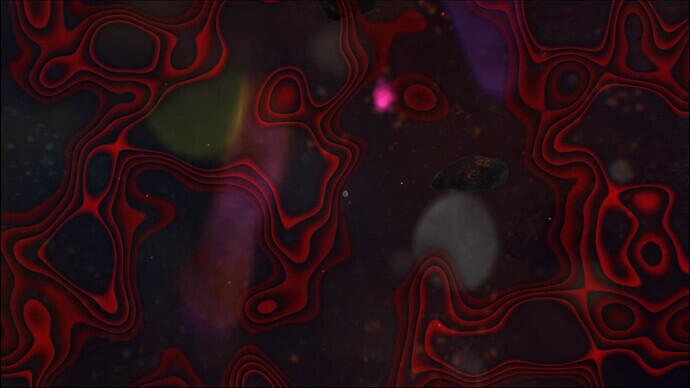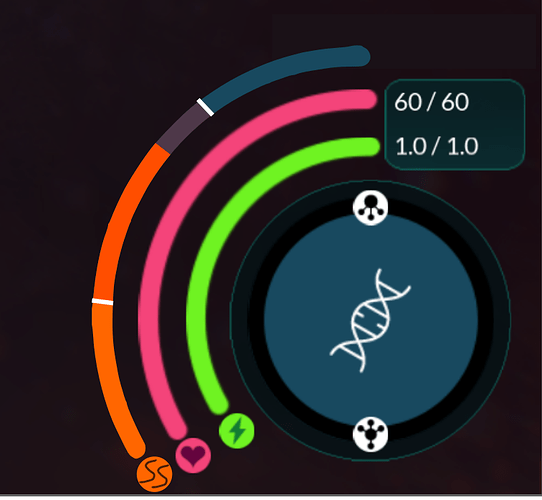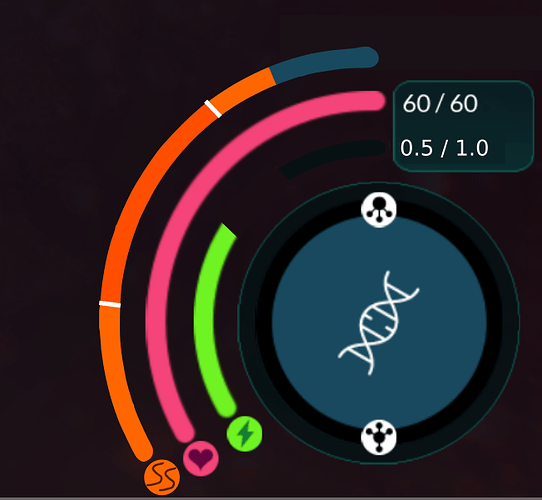Now that we are done with the release of 0.5.9, I feel it is a good time to posit the latest in thermosynthesis game design. For now, I’ll settle with a simple outline of each element of the concept, as well as a couple potential upgrades to the base part.
The gameplay
The key to thermosynthesis is to maintain a steady gradient between hot and cold so that sufficient ATP is produced. In order to do this players will need to keep an eye on the status of their internal gradient, and navigate between different temperature zones to ensure constant energy production.
One of the most important visual indicators for thermosynthesis is the gradient meter, which keeps the player informed on the current balance of their internal thermal gradient. It needs to be clean, concise, easily referred to, and out of the way.
The latest implementation of the gradient meter was in the form of a 3rd bar alongside the pre-existing ATP and health bars which seems to work well enough, so I’ll focus the concept around that idea.
This bar will fill up at a constant rate as long as the player dwells in a hot region, and begin to lower when they are in a cold region.
The most notable feature is the section separated by a couple brackets in middle of the bar. This is the “optimal gradient range” where thermosynthesis will produce the optimal amount of ATP. It is this amount that will be displayed in the part’s stats in the editor.
When the gradient level exceeds or falls below the optimal range, the player’s ATP production will begin to gradually decline. Should the player not stabilize their gradient in time, they will begin to starve.

With this new requirement for energy production, players will need a reliable method of navigating between hot and cold regions, thus it has been suggested that a visualization of the temperature differentials be granted to players with thermosynthetic parts.
These mechanics will see the player cruising between hot and cold regions in pursuit of maintaining their gradient. An interesting departure from the more straight-forward compound collection of most other diets.
The systems
Thermosynthesis is an unorthodox metabolism, and so it’s important to simplify aspects of the feature to ensure it remains understandable and easy to use for all players, and even autoevo as well.
Rate of Gradient Change:
In order to ensure that thermosynthesis is not an overly frustrating feature, the rate at which a cell’s gradient changes should remain fairly constant. Something like a maximum of 0.1 Δ in gain and loss assuming a capacity of 100 within the meter.
This rate will not be altered, or only slightly altered by the addition of more thermosynthetic parts; A departure from other parts which typically increase the process speed of an organism. This is so that thermosynthesis remains consistent and reliable in the absence of larger sources of sustenance otherwise available for other metabolic sources.
ATP Generation:
ATP generation via thermosynthesis will always remain constant as long as the gradient remains within the “optimal gradient range”, only beginning to drop off at a constant rate once the gradient leaves this range. This gives time for the player to correct their gradient before they suffer the consequences. Placing more thermosynthetic parts will simply increase the constant amount of ATP production, at the cost of increased mass and reproductive cost.
The optimal gradient range itself remains as a constant region of the bar, perhaps beginning at the 25% mark, and ending at 75% of the bar. It should give the player plenty of breathing room to focus on the world around them, but still present a persistent need to attend to.
Autoevo:
Unlike many other energy sources which simply require a sufficient amount of compound or the constant presence of an environmental condition, thermosynthesis requires a constant change between two extremes. This can make tracking the source somewhat tricky for autoevo, so simplification is likely within our best interests.
As Oliver has suggested, a good solution might be for thermosynthesis to behave just like photosynthesis in the eyes of autoevo. Only requiring sufficient temperature to function.
The science
In theory, thermosynthesis is mediated via special thermally responsive proteins that fold and unfold in response to changes in temperature.
When folded, the proteins clamp down on spent ADP, the kinetic energy of which forces the compound back into ATP. These proteins will refuse to release the ATP until subjected to a change in temperature, prompting them to unfold and release the now energized ATP molecule and be ready to repeat the process.
As a result, cells that rely on this theoretical process would need to constantly move between hot and cold regions of their environment to steadily power the enrichment of their ATP.
As you might gather; this is a highly inefficient and rather impractical process.
In Thrive, this process is intended to be simplified, so that it is more enjoyable and easier to understand. Thus instead of moving between hot and cold to regenerate ATP and then release it in cycles, cells will consistently be provided with ATP as long as they do not spend too long in cold or hot regions.

